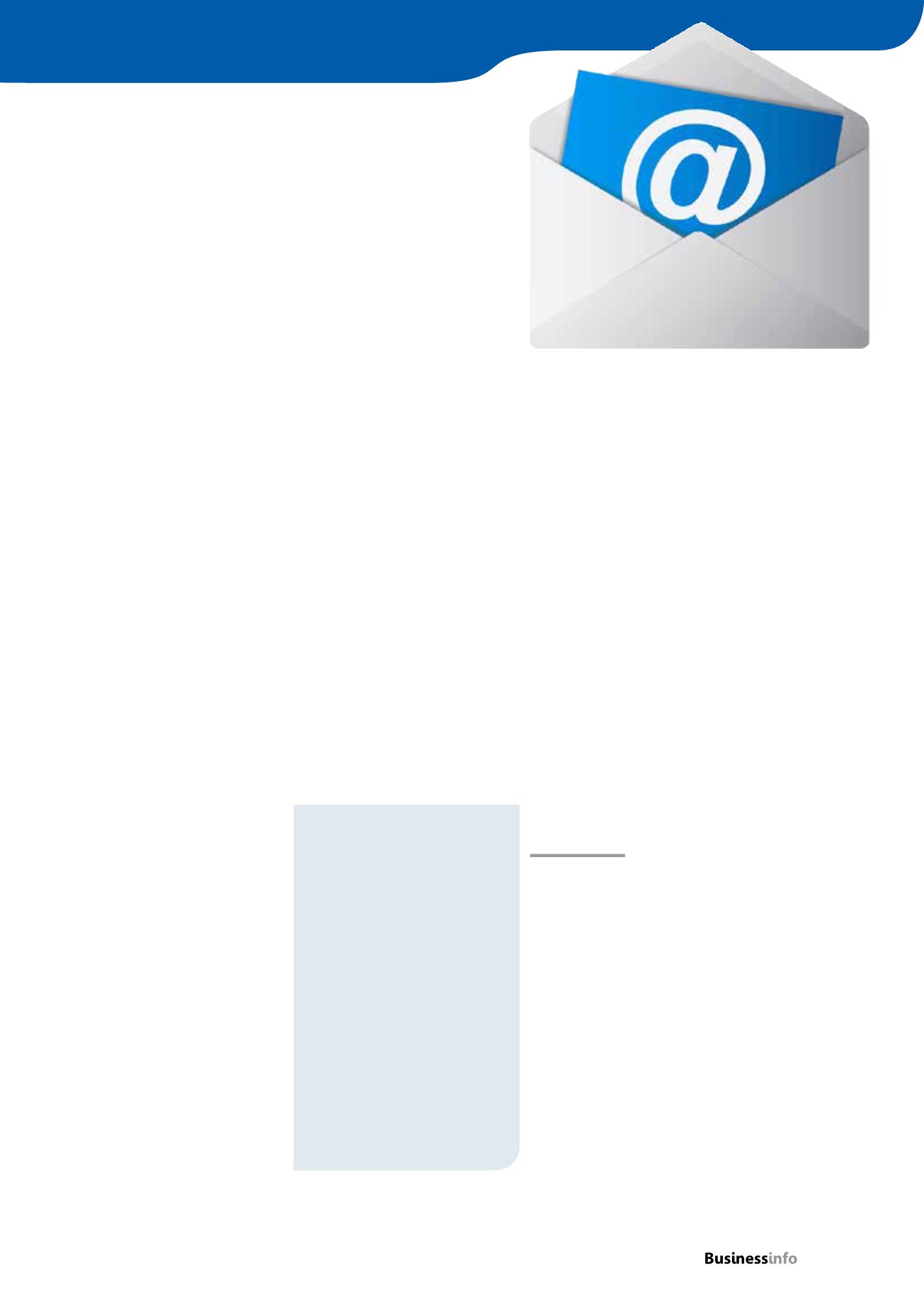
magazine
41
01732 759725
Communications
The enemy within
Email is the default communication
tool for business. It facilitates
collaboration among colleagues,
the sourcing of information and the
delegation of tasks. It’s easy to use
and ubiquitous – many businesses
would struggle without it.
Yet, disenchantment with email is
growing. Email tops the OfficeTime Top
10 Time Killers list, suggesting that for
many it has become more of a hindrance
than a help. But what exactly has caused
email to fall out of favour?
One big problem is simply the volume
of messages. This year, more than 205
billion emails will be sent and received
daily, and most of those by business
1
. No
wonder workers say email is the second
most time consuming activity after ‘role-
specific tasks’, taking up more than a
quarter of the average person’s working
day, according to the McKinsey Global
Institute
2
.
Email management is not just a
work problem; it spills into leisure time
too. The rise of the smartphone has
blurred the boundaries between work
and personal life, making it easy for
employees to check work email after-
hours or when on holiday. A GFI Software
study found that 73% of UK employees
check their email at weekends and 44%
admit to checking it after 11pm.
And the problem cuts both ways, with
50% of workers sending and receiving
personal email during office hours,
according to the Yougov report
Switching
off Technology and theWork-Life Balance.
A drain on productivity
These trends have implications across
the board. For the employer, email has
become a costly drain on productivity,
slowing down decision-making and
leaving less time for other tasks. Cloud-
based email specialist Mailprotector
calculates that managing unwanted
email could be costing medium-sized
businesses more than £34,000 a year.
For employees, rising email volumes
contribute to stress and make it hard
for staff to switch off after work. A 2014
study in the
Journal of Occupational
Health Psychology
by Barber and
Santuzzi links the overwhelming urge
to respond to email with physical and
cognitive burnout, poor sleep quality and
absenteeism. A study by the University of
California, Irvine (UCI) shows that when
workers are cut off from email, their
focus improves and stress levels fall.
So what can businesses and
individuals do to avoid email overload
and its effects? One approach is
behavioural – implementing strategies
to control how email is used; the
other is technological – implementing
alternative communications solutions.
Changing behaviour
Promoting email best practice through
education and rules can have a big
impact on email volumes. The following
recommendations are a good starting
point:
n
Talk more.
Communication at work
is often dominated by email. Yet calling
or speaking face-to-face is often more
effective.
n
Allocate time.
Many people leave
their inbox open all day. This exposes
them to the distraction of new
message notifications and the constant
temptation to check their email. To stay
on-task, check email at set times instead.
n
Keep it short.
The longer the
message, the more time it will take
someone to read and the longer their
reply is likely to be. Keep your emails
succinct with clear subject lines so
Tayla Ansell on email hell and how to avoid it
that the reader can quickly assess their
importance.
n
Send fewer emails.
To receive fewer
emails, don’t send so many. Think before
you click ‘reply all’ or CC everyone into
an email. Setting email quotas might
encourage employees to think twice
before clicking send.
n
Organise your inbox.
De-clutter your
inbox by archiving mail you want to keep
and use a solution like Unroll. Me to
unsubscribe from newsletters and social
media alerts that you no longer want.
n
Prioritise.
Label emails that require
action on your part so that you can
prioritise them. A setting in Gmail called
Priority Inbox attempts to identify
important incoming messages and
automatically separate them from the
rest.
n
Take email breaks.
Encourage
employees to switch-off after work and
take a break from email – or force them
to do so by denying access to email
servers outside office hours.
Changing technology
Changing behaviour can have a big
impact on email volumes. A more
radical solution is to adopt a different
communication method as an alternative
to, or replacement for, email.
This is just what IT services company
Atos Origin chose to do in 2011. After
discovering that managers were spending
5-20 hours a week reading and writing
email, it adopted a social media platform
for internal communications and by doing
so has reduced email volumes by 60%.
There are plenty of enterprise social
networks to choose from. Solutions
like Slack, Asana, Yammer and Convo
typically combine instant messaging, file
sharing and task management so that
teams can work together on projects and
keep all data in one place, accessible by
smartphone, tablet or PC.
Adopting a business social network
will certainly curb the number of internal
emails sent and received. Just make sure
it doesn’t become yet another platform
for workers to check 24/7.
Top 10 Time Killers
Based on the percentage of people
who spend 1-4 hours per day on the
activity.
1. Email (43.5%)
2. Meetings (42.3%)
3. Surfing the Internet (21.8%)
4. Travel time/commuting (17.4%)
5. Procrastination (10%)
6. Non-business conversations (7%)
7.Watching TV or Internet videos
(6.9%)
8. Break time (6.5%)
9. Social networking for business
(5.8%)
10. Dealing with computer problems
(5.6%)
(source: OfficeTime, 2014)
[1]
Email Statistics Report 2015-2019
, The Radicati Group, Inc.
[2]
The social economy: unlocking value and productivity through
social technologies
, McKinsey Global Institute, July 2012
This year,
more than
205 billion
emails will
be sent and
received daily


